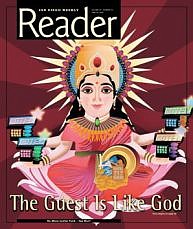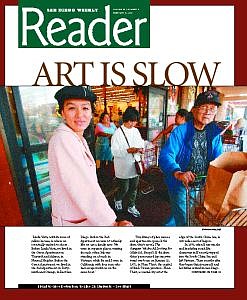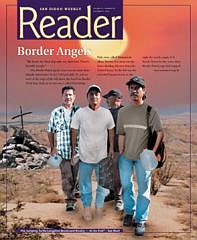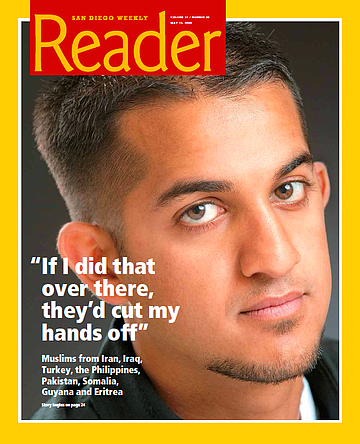 Facebook
Facebook
 X
X
 Instagram
Instagram
 TikTok
TikTok
 Youtube
Youtube


One Sunday in November 1989, Barry Lall, an Indian-American doctor, was driving over the Coronado Bridge with his wife Hema, their four-year-old son Arjun, Lall's father and mother, and a real estate broker. They were on their way to inspect a 12-room motel for sale at the corner of Third Street and Orange Avenue, which, if priced right, Lall hoped to buy. Beneath them was the beautiful blue and iridescent channel, the port of San Diego where ships off-load containers from as far away as Hong Kong. At the time, Lall, who was practicing family medicine at Kaiser Hospital in Chula Vista, was not yet a citizen. He was here by way of a transnational diaspora common to many Indian immigrants.
By Thomas Larson, June 29, 2006 | Read full article

They hopped trains, took buses, spent long days walking. When their path took them through remote areas, they went hungry. Every week a sheet of paper rolls off a fax machine at the Casa Cornelia Law Center on Laurel Street. It contains a list of two or three dozen names, each followed by a date and country of birth. A prosaic document, it's an accounting of children who've been apprehended by local immigration authorities. These are youngsters who've wound up in San Diego County alone, unaccompanied by their families, thousands of miles from their homes. To get here, many have endured hair-raising journeys. All of them thought they were about to make a new life in America.
By Jeannette DeWyze, Feb. 3, 2005 | Read full article

“Linda Vista, with its rows of yellow houses, is where we eventually washed to shore. Before Linda Vista, we lived in the Green Apartment on Thirtieth and Adams, in Normal Heights. Before the Green Apartment, we lived in the Red Apartment on Forty-ninth and Orange, in East San Diego. Before the Red Apartment we weren’t a family like we are a family now. We were in separate places, waiting for each other. Ma was standing on a beach in Vietnam while Ba and I were in California with four men who had escaped with us on the same boat.”
This litany of place names and apartments opens lê thi diem thúy’s novel, The Gangster We Are All Looking For (Alfred A. Knopf). lê thi diem thúy (pronounced lay-tee-yim-twee) was born on January 12, 1972, in Phan Thiet, the capital of Binh Thuan province. Phan Thiet, a coastal city set at the edge of the South China Sea, is 100 miles east of Saigon.
By Judith Moore, Feb. 5, 2004 | Read full article

"We know the kind of people we catch here. They're horrible people." The Border Patrol agent's tone was no more than blandly informative. It was 7:00 p.m. July 16, and we were at the edge of the hill above the beach in Border Field State Park, in an area once called Friendship Park, now called Monument Mesa. Twenty feet away ran the fence dividing Mexico from the United States. To the left was the crowded Tijuana beach, to the right the nearly empty U.S. beach. Down by the water three Border Patrol jeeps had stopped as two agents questioned a group of four Hispanics. A nearby sign warned of "sewerage contaminated water," rip tides, and no lifeguards.
By Stephen Dobyns, Dec. 7, 2006 | Read full article

What’s it like, being Muslim in San Diego?
The question arose for me earlier this year when I decided to hit Ocean Beach on maybe the worst night of the winter. It was Wednesday, the end of market day. Rainstorms exploding in off the Pacific, marquees flapping, most market folks packing up, re-boxing their fruit. But not the guys in the black tent near where Bacon crosses Newport. From inside the gust-wrenched canvas, half a dozen men shouted to scurrying passersby to come on in for the ultimate hand-warmer. Guled and Mohammed and Abdi and Hamza and a bunch of other young Somali men were selling the thing I’d weathered the storm to find: samosas, the Middle East and India’s great snack gift to the world.
By Bill Manson, May 14, 2008 | Read full article

I’m listening to attorney Eleanor Adams, who’s been practicing immigration law locally for 25 years. By phone, she’s outlining, breathlessly, our labyrinthine federal system of percentage quotas, monthly resets, and congressional reform proposals for the two big categories of immigrants: family-sponsored (relatives) and employment-based (workers). As of 2009, immigrants composed 12.5 percent of the population — 38 million souls. A little less than half of those are naturalized; the rest reside here legally or illegally.
By Thomas Larson, Dec. 31, 2013 | Read full article



One Sunday in November 1989, Barry Lall, an Indian-American doctor, was driving over the Coronado Bridge with his wife Hema, their four-year-old son Arjun, Lall's father and mother, and a real estate broker. They were on their way to inspect a 12-room motel for sale at the corner of Third Street and Orange Avenue, which, if priced right, Lall hoped to buy. Beneath them was the beautiful blue and iridescent channel, the port of San Diego where ships off-load containers from as far away as Hong Kong. At the time, Lall, who was practicing family medicine at Kaiser Hospital in Chula Vista, was not yet a citizen. He was here by way of a transnational diaspora common to many Indian immigrants.
By Thomas Larson, June 29, 2006 | Read full article

They hopped trains, took buses, spent long days walking. When their path took them through remote areas, they went hungry. Every week a sheet of paper rolls off a fax machine at the Casa Cornelia Law Center on Laurel Street. It contains a list of two or three dozen names, each followed by a date and country of birth. A prosaic document, it's an accounting of children who've been apprehended by local immigration authorities. These are youngsters who've wound up in San Diego County alone, unaccompanied by their families, thousands of miles from their homes. To get here, many have endured hair-raising journeys. All of them thought they were about to make a new life in America.
By Jeannette DeWyze, Feb. 3, 2005 | Read full article

“Linda Vista, with its rows of yellow houses, is where we eventually washed to shore. Before Linda Vista, we lived in the Green Apartment on Thirtieth and Adams, in Normal Heights. Before the Green Apartment, we lived in the Red Apartment on Forty-ninth and Orange, in East San Diego. Before the Red Apartment we weren’t a family like we are a family now. We were in separate places, waiting for each other. Ma was standing on a beach in Vietnam while Ba and I were in California with four men who had escaped with us on the same boat.”
This litany of place names and apartments opens lê thi diem thúy’s novel, The Gangster We Are All Looking For (Alfred A. Knopf). lê thi diem thúy (pronounced lay-tee-yim-twee) was born on January 12, 1972, in Phan Thiet, the capital of Binh Thuan province. Phan Thiet, a coastal city set at the edge of the South China Sea, is 100 miles east of Saigon.
By Judith Moore, Feb. 5, 2004 | Read full article

"We know the kind of people we catch here. They're horrible people." The Border Patrol agent's tone was no more than blandly informative. It was 7:00 p.m. July 16, and we were at the edge of the hill above the beach in Border Field State Park, in an area once called Friendship Park, now called Monument Mesa. Twenty feet away ran the fence dividing Mexico from the United States. To the left was the crowded Tijuana beach, to the right the nearly empty U.S. beach. Down by the water three Border Patrol jeeps had stopped as two agents questioned a group of four Hispanics. A nearby sign warned of "sewerage contaminated water," rip tides, and no lifeguards.
By Stephen Dobyns, Dec. 7, 2006 | Read full article

What’s it like, being Muslim in San Diego?
The question arose for me earlier this year when I decided to hit Ocean Beach on maybe the worst night of the winter. It was Wednesday, the end of market day. Rainstorms exploding in off the Pacific, marquees flapping, most market folks packing up, re-boxing their fruit. But not the guys in the black tent near where Bacon crosses Newport. From inside the gust-wrenched canvas, half a dozen men shouted to scurrying passersby to come on in for the ultimate hand-warmer. Guled and Mohammed and Abdi and Hamza and a bunch of other young Somali men were selling the thing I’d weathered the storm to find: samosas, the Middle East and India’s great snack gift to the world.
By Bill Manson, May 14, 2008 | Read full article

I’m listening to attorney Eleanor Adams, who’s been practicing immigration law locally for 25 years. By phone, she’s outlining, breathlessly, our labyrinthine federal system of percentage quotas, monthly resets, and congressional reform proposals for the two big categories of immigrants: family-sponsored (relatives) and employment-based (workers). As of 2009, immigrants composed 12.5 percent of the population — 38 million souls. A little less than half of those are naturalized; the rest reside here legally or illegally.
By Thomas Larson, Dec. 31, 2013 | Read full article
Comments